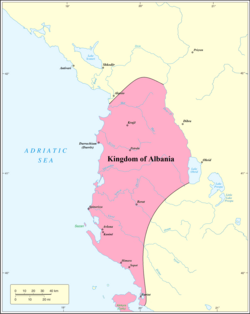
Back مملكة ألبانيا (العصور الوسطى) Arabic Албанско кралство Bulgarian Regne d'Albània (edat mitjana) Catalan Albánské království (1272–1368) Czech Regnum Albaniae German Βασίλειο της Αλβανίας (Μεσαίωνας) Greek Reino de Albania (medieval) Spanish Albaania kuningriik (keskaegne) Estonian Albaniako Erresuma (Erdi Aroa) Basque Royaume médiéval d'Albanie French
Kingdom of Albania | |||||||||||||||
|---|---|---|---|---|---|---|---|---|---|---|---|---|---|---|---|
| 1271–1368 1376–1383 | |||||||||||||||
 Kingdom of Albania at its maximum extent (1272-1274) | |||||||||||||||
| Status | Personal union with the Angevin Kingdom of Sicily/Naples | ||||||||||||||
| Capital | Durazzo (Dyrrhachium, modern Durrës) | ||||||||||||||
| Religion | |||||||||||||||
| Government | Monarchy | ||||||||||||||
| King, Lord and later Duke | |||||||||||||||
• 1272–1285 | Charles I | ||||||||||||||
• 1285–1294 | Charles II | ||||||||||||||
• 1294–1331 | Philip I | ||||||||||||||
• 1331–1332 | Robert II | ||||||||||||||
• 1332–1336 | John, Duke of Durazzo | ||||||||||||||
• 1336–1348 | Charles, Duke of Durazzo | ||||||||||||||
• 1348–1368, 1376-1383 | Joanna, Duchess of Durazzo | ||||||||||||||
• 1365–1368,1376 | Louis, Duke of Durazzo | ||||||||||||||
• 1376-1383 | Robert IV of Artois, Count of Eu | ||||||||||||||
| Historical era | Medieval | ||||||||||||||
• Established | 1271 | ||||||||||||||
• Disestablished | 1368 1376–1383 | ||||||||||||||
| ISO 3166 code | AL | ||||||||||||||
| |||||||||||||||
The Kingdom of Albania (Albanian: Mbretëria e Arbërisë, Latin: Regnum Albaniæ) was established by Charles of Anjou in the Albanian territories he conquered from the Byzantine Empire in 1271, with the help of the local Albanian nobility. The Kingdom of Albania was declared in late February 1272. The kingdom extended from the region of Durazzo (Dyrrhachium, modern Durrës) south along the coast to Butrint. A major attempt to advance further in direction of Constantinople failed at the Siege of Berat (1280–1281). A Byzantine counteroffensive soon ensued, which drove the Angevins out of the interior by 1281. The Sicilian Vespers further weakened the position of Charles, and the Kingdom was soon reduced by the Byzantines to a small area around Durazzo. The Angevins held out here, however, until 1368, when the city was captured by Karl Thopia. In 1392, Karl Thopia's son surrendered the city to the Republic of Venice.
